A lunar sample collected by astronaut John Young, BSAE 1952 is on display at Georgia Tech.
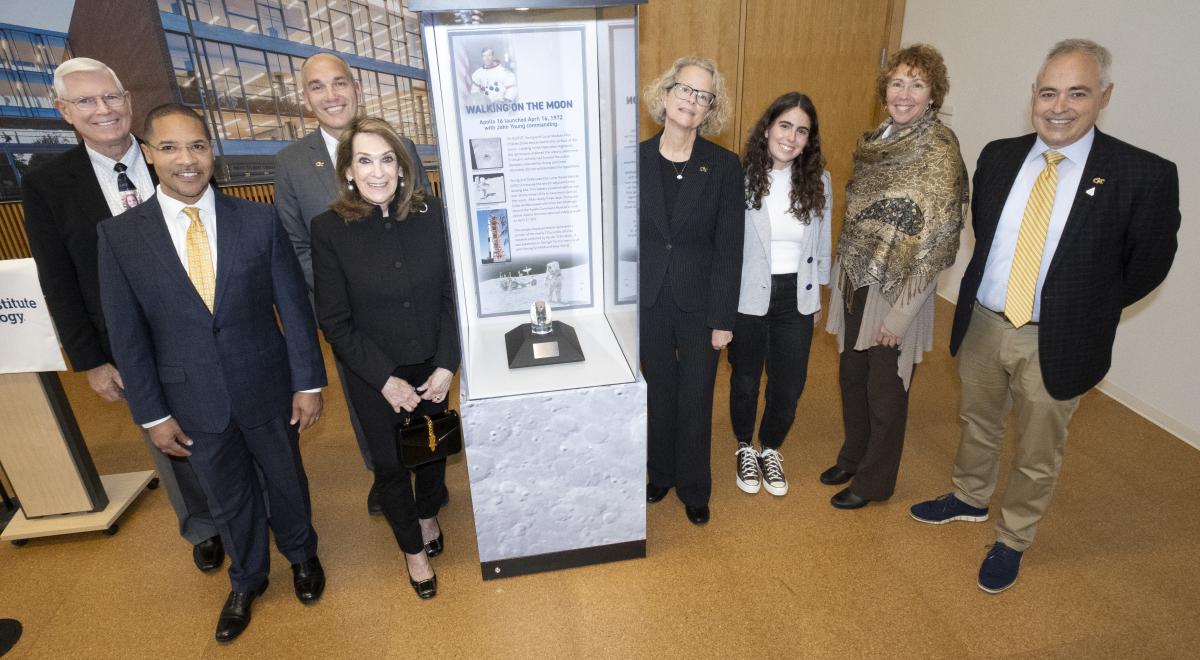
On Display: from left, Mike Coats, Mitchell Walker, Mark Costello, Susy Young, Leslie Sharp, Cayetana Salinas, Sandy Magnus, and Georgia Tech President Ángel Cabrera unveil the Apollo 16 lunar sample collected by John Young, BSAE 1952 during private ceremony. View more photos
Fifty-one years ago, Georgia Tech alumnus John Young, BSAE 1952, Ph.D. Hon 2003, walked and drove on the moon as commander of the Apollo 16 mission. He and his crew returned to Earth with 209 pounds of lunar samples in tow. Now a piece of one of those rocks has come to his alma mater. On loan from the Young family and NASA, the lunar sample is now on display on the Grove-level of the Price Gilbert Library. A private unveiling ceremony included Young's family, friends, former NASA colleagues, and Georgia Tech leadership.
“A key element of our achievements in space and our future aspirations lie in our continuous investment in university research as well as inspiring and mentoring the next generation of engineers and scientists,” said Mark Costello, and William R. T. Oakes Professor and AE School Chair. “I want to thank Susy Young, her family and friends for being with us to celebrate Captain Young’s contributions to humanity and the establishment of the John Young Chair in Aerospace Engineering.”
(text and background only visible when logged in)
Lunar Sample
The sample collected at the Apollo 16 landing site is estimated to have been on the moon for at least 400 million years. Young and Charles M. Duke gathered it during Apollo 16’s second extravehicular activity (EVA) at the base of Stone Mountain, a codename Young gave to what NASA calls the Descartes site in the lunar highlands.
The sample is made from a rock type called impact melt breccia. This rock typically forms during very large impacts when much of the rock melts due to the energy from a major collision. The impact melt breccia that later became the lunar sample on display, was formed 3.9 billion years ago during the Imbrium impact event. This event formed the Imbrium Basin, a 1,100-kilometer diameter impact crater that has since been largely filled with mare basalt. It’s the largest impact on the nearside of the Moon, and one of the last major impact basins.
Since making Earth its new home, the sample has been stored in a nitrogen-purged glove box at the Apollo Sample Laboratory at NASA Johnson Space Center, along with all of the other Apollo samples. During its time in the curation labs, researchers have carefully subdivided the sample into more than 250 smaller subsamples, which have been used for numerous scientific studies to increase humanity’s understanding of the moon and the formation of our solar system.
(text and background only visible when logged in)
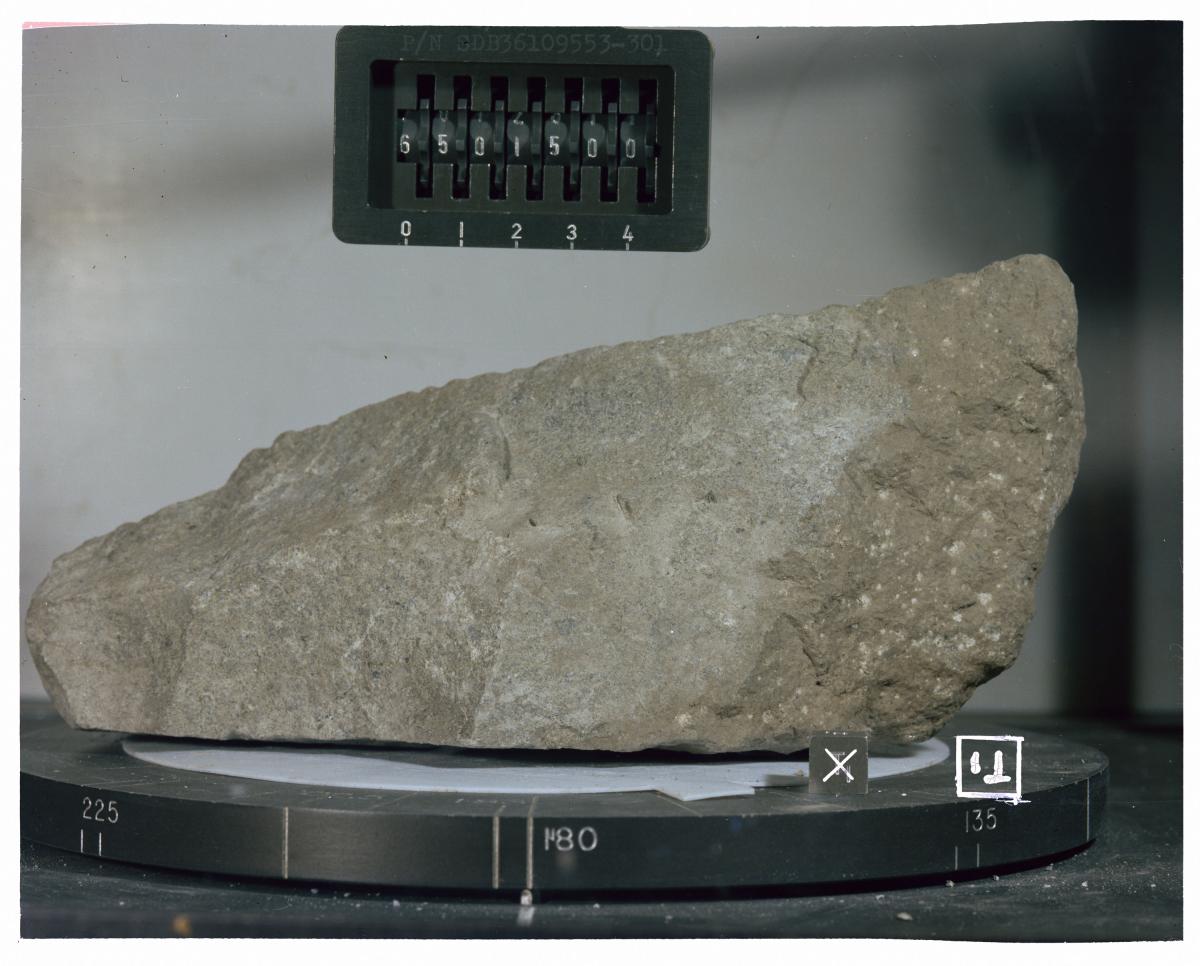
The original sample collected from the Decartes site (credit: NASA)

Black and white photograph of Apollo 16 Sample(s) 65015 (credit: NASA)
(text and background only visible when logged in)
Sweet 16
Apollo 16’s Saturn-V rocket lifted off from Launch Complex 39A on April 16, 1972, at NASA’s Kennedy Space Center in Florida. The spacecraft entered lunar orbit three days later. On April 20, Young and Duke separated with their lunar module, Orion, to descend to the moon’s surface. Crewmate Thomas “Ken” Mattingly stayed in orbit aboard the command module, Casper.
Once the lunar module landed, Young couldn’t help but take a moment to describe the scenery to Mission Control, “We just can't find any words. Everybody's peeking out the window here,” he said.
The mission had three primary objectives: surveying and sampling materials and surface features near the Descartes region, installing and activating surface experiments, and conducting in-flight experiences and photographic tasks from lunar orbit. As soon as they settled on the moon’s surface, it was clear they had picked a good landing site. Young looked out the window and reported, “Well, we don't have to walk far to pick up rocks, Houston. We're among them!”
Young and Duke spent the next 20 hours and 14 minutes exploring the region, gathering samples, and driving 16.6 miles using the Lunar Roving Vehicle during three separate EVAs. The cameras onboard Orion, as well as those used by Young and Duke, captured images and provided information that verified Apollo 15 data on lunar terrain that was previously unknown.
On April 27, all three astronauts safely splashed into the Pacific Ocean and were picked up by the U.S.S. Ticonderoga. With the successful completion of what became the penultimate Apollo mission, Young became the first person to orbit the moon on two separate missions, the first being Apollo 10 in 1969. The success of the fifth human landing on the moon led way to the advancements in many areas of technology and laid the foundation for future human spaceflight capabilities.
(text and background only visible when logged in)
(text and background only visible when logged in)
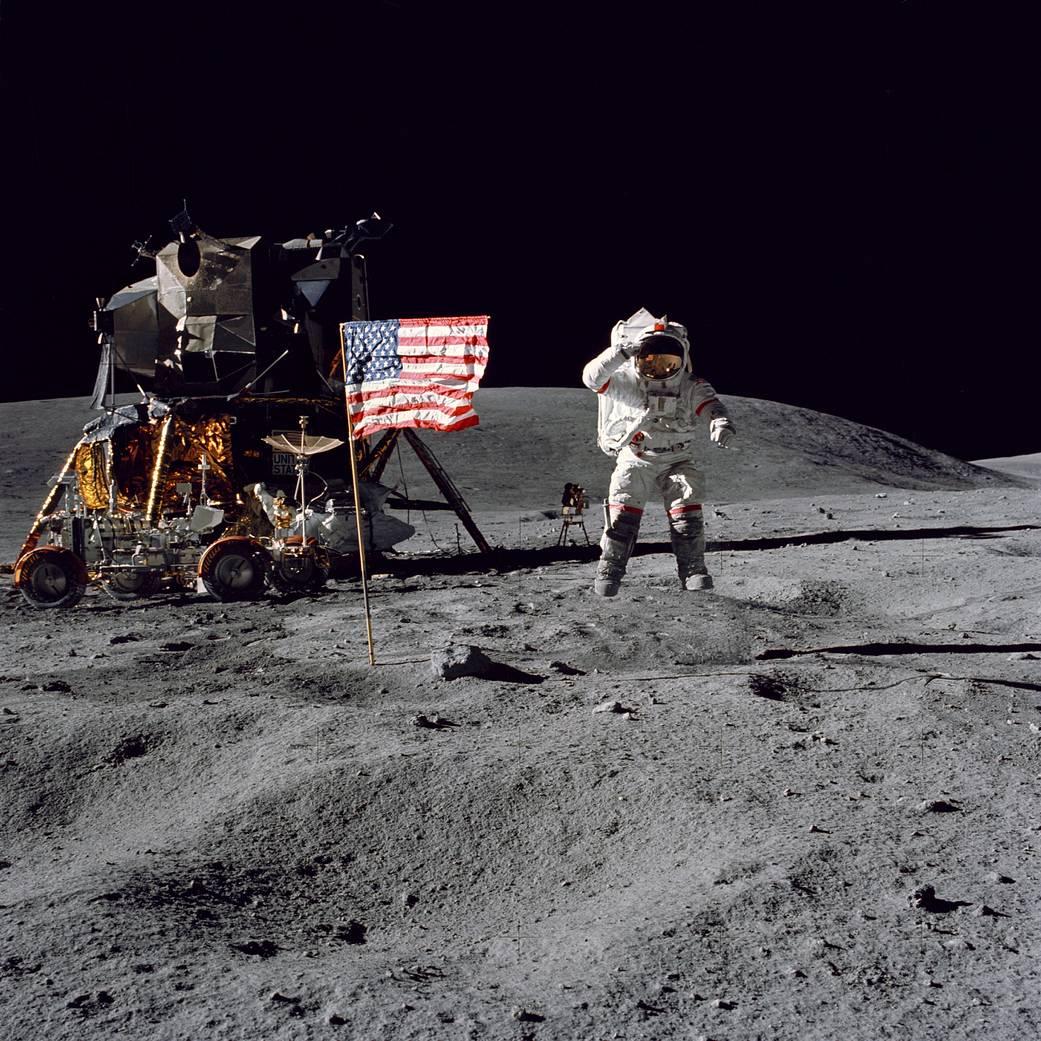
The iconic photo was taken during the Apollo 16 mission. The UV astronomy camera, the flag, the Lunar Module, the Rover with the TV camera watching Young, and Stone Mountain can all be seen in the background. (credit: NASA)
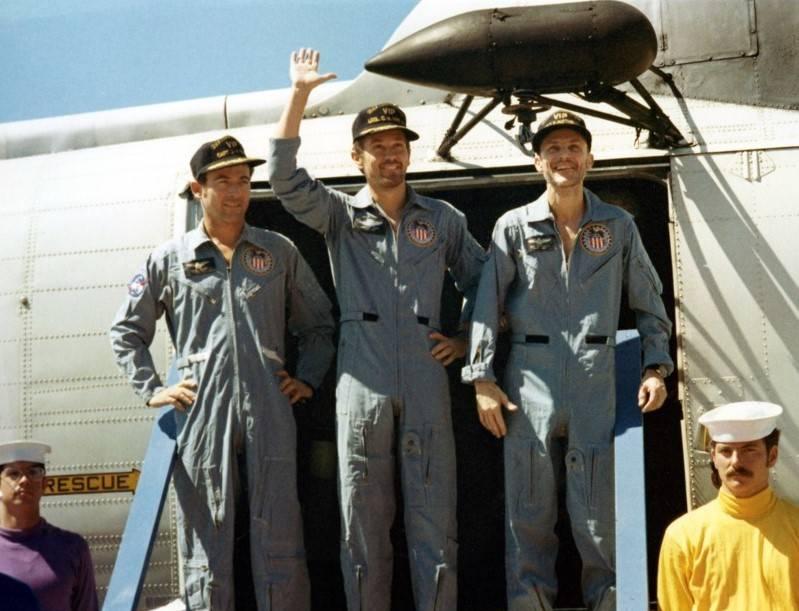
Apollo 16 astronauts John W. Young, left, Charles M. Duke, and Thomas K. “Ken” Mattingly exit the recovery helicopter on the deck of the prime recovery ship U.S.S. Ticonderoga
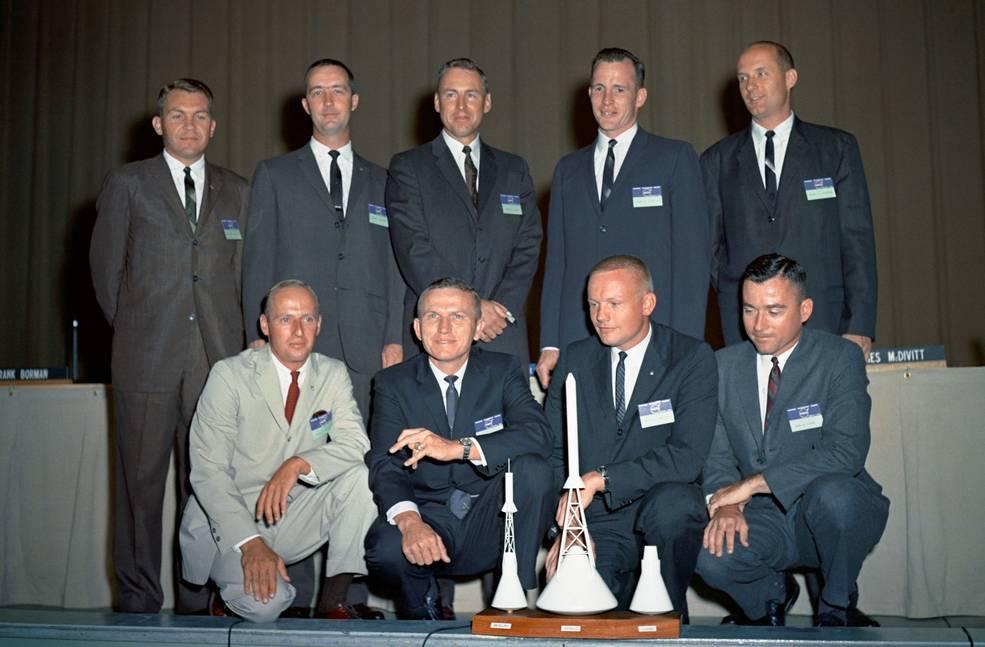
NASA Astronaut Group 2, back row, left to right: See, McDivitt, Lovell, White, Stafford. Front row: Conrad, Borman, Armstrong, Young. Before them are models of the Mercury, Apollo, and Gemini spacecraft.(credit: NASA)
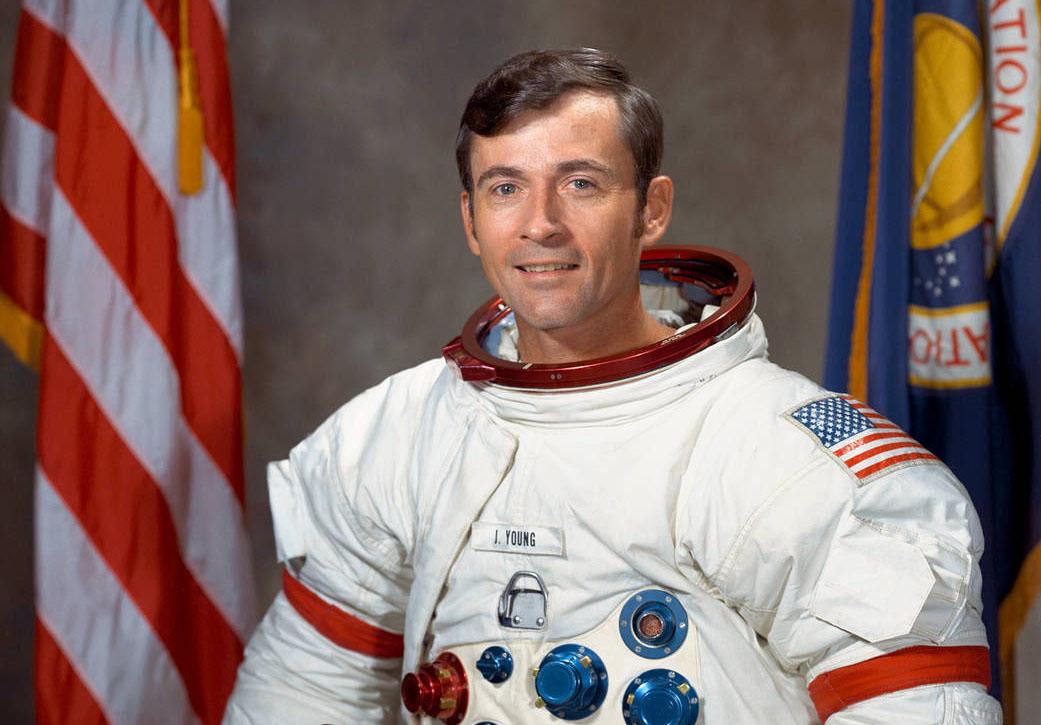
October 1971 portrait photograph of Astronaut John W. Young in spacesuit with a Lunar globe in front of him and an American flag. (credit: NASA)
(text and background only visible when logged in)
Forever Young
Young grew up in Orlando, Florida, before making his way to Atlanta to begin his aerospace engineering studies. As a Tech student, Young was a member of Scabbard and Blade, Sigma Chi, Tau Beta Pi, Tau Omega, Student Council, Circle “K” Club, and R.O.T.C.
He graduated from Georgia Tech in 1952 with the highest honors before joining the U.S. Navy, where he flew fighter planes and served at the Navy’s Air Test Center in Maryland. There, he worked alongside Apollo 13 commander James A. Lovell Jr. and tested and evaluated Crusader and Phantom fighter weapons systems. Just 10 years after receiving his degree, Young was selected for NASA’s second astronaut group, which included Lovell and Neil Armstrong. Over his 42-year NASA career, he logged more than 15,275 hours of flying time in props, jets, helicopters, and rocket jets; more than 9,200 hours in T-38s; and six space flights of 835 hours. He’s the only astronaut to fly in NASA's Gemini, Apollo, and Space Shuttle programs, and was often called “the most experienced astronaut of all time.”
After 25 years of service in the Navy, Young retired as a captain in 1976 and retired from NASA in 2004. He continued to advocate for space technology and advancement that would take humans back to the moon and, one day, Mars. Young passed away on January 5, 2018, at the age of 87 from complications of pneumonia.
Today, Young is the first – and only – Tech graduate to walk on the moon, but many aspiring astronauts at Georgia Tech hope to join him. In 2021, the Daniel Guggenheim School of Aerospace Engineering (AE School) announced the John Young Endowed Chair position in honor and memory of the late astronaut. In August 2022, Mitchell Walker was named the inaugural John Young Chair for creating next-generation space technologies associated with electric propulsion systems. Walker is an internationally recognized scholar in the area of electric space propulsion and known as an incredible mentor to students.
(text and background only visible when logged in)
(text and background only visible when logged in)

Georgia Tech BluePrint
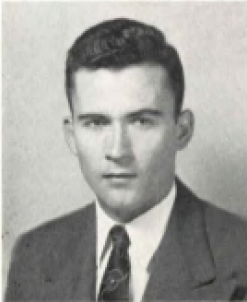
John Young
Senior photo in 1952 BluePrint
(text and background only visible when logged in)
(text and background only visible when logged in)
Related Stories

A Legacy Not Forgotten
Georgia Tech graduate John Young remembered as the most experienced astronaut in history
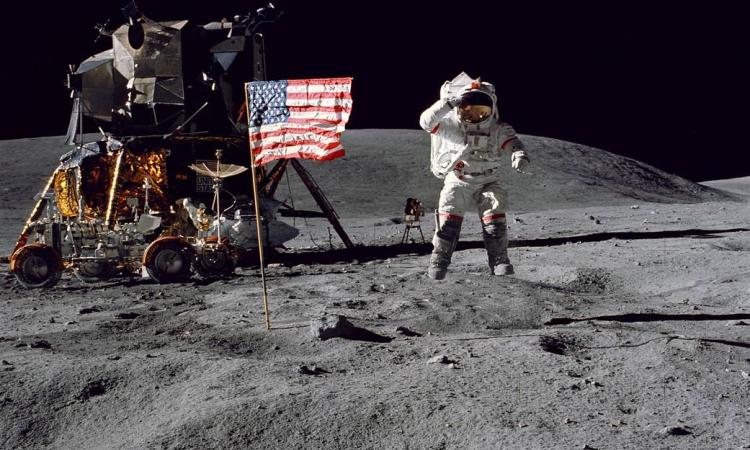
Remembering John Young, AE Class of 1952
On January 5, 2018, the world lost a true American hero. On January 5, 2020, we are called to remember him.